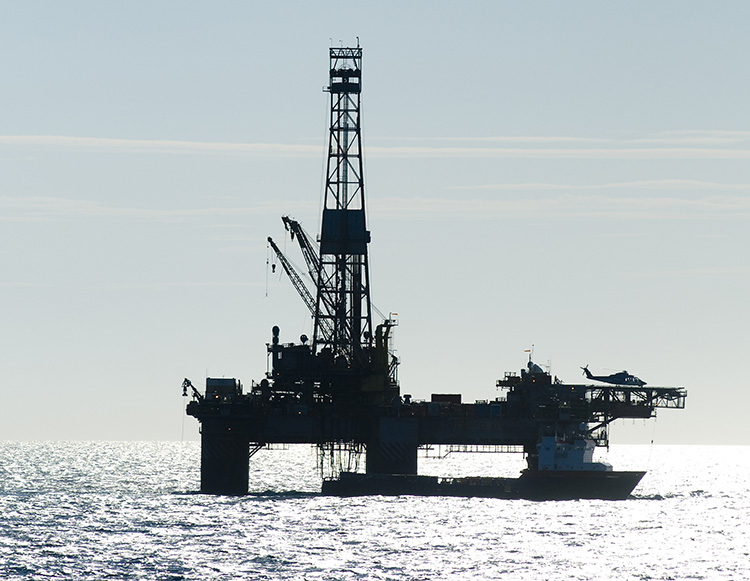General Overview of the Environmental Impacts of Offshore Drilling
To begin with, the oil and gas sector is known to have some of the most prominent and paramount projects that are often located offshore. It is important to note that Egypt is home to some of the largest oil and gas projects in the region. In fact, Egypt aims to become the regional natural gas hub in the coming years.
To elaborate, according to the Ministry of Petroleum and Mineral Resources, Egypt is looking to expand its offshore market through the development and operation of 11 exploration and production (E&P) projects by fiscal year (FY) 2019/20. Such offshore projects are expected to be set in various locations including the Mediterranean Sea, Gulf of Suez, Delta, as well as the Western Desert. The implementation of such projects is expected to increase the country’s production by nearly 32,000 barrels per day (b/d) of crude oil and condensates, along with approximately 2.5 billion cubic feet per day (bcf/d) of natural gas.
While Egypt’s oil and gas industry is expected to thrive even further in the future, there is an important feature that has been drastically overlooked in the implementation of offshore projects: the preservation of marine life. Offshore developments negatively impact marine life during all stages of the project. There are various endangered species living in the Egyptian offshore territory; these include turtles, sea cucumbers, coral reefs, mangrove trees, and even certain species of birds. From drilling to commissioning, the preservation and conservation of any and all living creatures must be taken seriously in order to ensure that no harm comes to such endangered species.
Endangered Marine Life in Egypt
Essentially, Egypt is home to a multitude of species of marine life. In fact, the Red Sea alone contains more than 1,200 species of fish, 800 species of mollusks, 600 species of crustaceans, 200 species of coral reefs, and 300 species of birds; of such species, 17% of the entire world’s marine life is located in the Red Sea alone. For this reason, it is absolutely crucial to ensure that the life cycle of all living creatures continues without negative human intervention in natural phenomena.
While there is an abundance in marine life species along the coasts of Egypt, it should be noted that there is a rapid and steady decline in the number of marine creatures and their respective habitats. As a matter of fact, there has been an overall decline in the number of fish species by nearly 23% over the course of the 21st century. While this value may not necessarily be alarming to many, the truly perturbing fact is that this decline is expected to continue unless strenuous actions and legislations are implemented. For this reason, it is imperative to make others aware of the potential implications of offshore oil projects to minimize the harm caused to any and all marine life.
To elaborate, all living creatures can be categorized into two main categories: invertebrates (animals without backbones or a skeleton) and vertebrates (animals with skeletons and/or backbones). On one hand, vertebrates are considered to be inclusive of mammals, birds, and fins (i.e. fish species). On the other hand, invertebrates include species such as insects, molluscs and crustacea (i.e. crabs and shrimps), echinoderms (i.e. sea urchins), etc. In Egypt, it was found that there are 43 endangered species of vertebrates and 3 endangered species of invertebrates.
As a whole, marine biodiversity in Egypt has reached nearly 5,000 species; this is not inclusive of the hundreds of predicted unrecorded species yet to be found in the volatile underwater environment. Therefore, it can be noted that there are multiple species that are on the very brink of extinction and they must be preserved to ensure the ecosystem is not disturbed in anyway by manmade interruptions.
Offshore Drilling and its Impact on Marine Life
There are many ways in which deep-sea drilling impacts the marine environment. Typical deep-sea drilling activities can have deleterious effects throughout the main phases of the project, including exploration, production, and decommissioning. While the environmental impact of exploration typically takes place onshore, production-related activities affect marine environment via drill cutting, drilling fluids, and anchor chains. However, the most impactful phase of the project on marine environment is the decommissioning phase; this is mainly due to the fact that contaminants and by-products could be released in the sea bed at over 1,000 meters below sea level.
Also, what may seem like minor inconveniences to others are actually major inconveniences for marine life. For instance, in order for any drilling to take place, sufficient lighting of the underwater area is required via electric lighting or gas flares. By installing artificial lighting at sea bed level – where there is a lack of light – predatory creatures are attracted to hunt prey that depend on the darkness of the sea bed for survival; this human intervention alters the ecosystem as prey will be left to be hunted or flee from their present habitats. Usually, this example includes large squid and fish species hunting smaller fish and plankton.
Another example of how offshore drilling could affect marine life is through the emissions released from operational gen-sets. To be precise, the gen-sets operating on the offshore rig platforms produce greenhouse gas emissions that are released into the atmosphere. This phenomenon, in turn, affects birds flying overhead either for migratory or hunting purposes. The smoke from the chemicals released affects the air quality, which forces birds to alter their flight paths and/or look elsewhere for food. While this may not seem to affect marine life, the fish that are usually hunted, now accumulate and feed on other smaller species; this indirectly alters the ecosystem of underwater species.
Artificial lighting is only one example of many features of offshore drilling that negatively impact marine life, such as noise levels from drilling, habitat invasion, fluctuating temperatures, and even changing water content from waste by-products. For this reason, it is important to ensure that routine environmental inspections are regularly carried out to mitigate any unnecessary environmental complications.
Regulations and Concepts to Conserve and Protect the Environment
Currently, there are various strategies and plans enforced by the Egyptian Environmental Affairs Agency (EEAA) under the umbrella of the United Nations Environmental Program (UNEP). To be specific, the “Convention for the Protection of the Marine Environment and the Coastal Region of the Mediterranean” is an action plan created to ensure the protection and conservation of any and all forms of marine life via stringent protocols. In general, permits and approvals must be attained directly from the EEAA before oil and gas companies get the greenlight to start on projects that may have negative impacts on the environment.
The main aims of the convention are to assess and mitigate marine pollution, enhance the marine environment, contribute towards a more sustainable environment, protect natural and cultural heritage, and strengthen ties between Mediterranean coastal states. In fact, Article 30 of the convention specifically aims to combat harmful substances deployed into the sea.
For instance, deep-water oil and gas projects often lead to the production of crude oil emulsions (i.e. the mixture of oil, water, and gas products). Emulsions could fatally affect marine life and even damage their respective habitats. As suggested by Oil and Gas Consultant, Mahmoud Shawkat, “Technically, Hydrocarbon production is usually associated with water where emulsion exists. This needs treatment before dumping into the sea or recycling for water injection to get rid of the residual oil. This is one part; the other is deep-water drilling is challenged with surface hole drilling where collecting the return mud is difficult and needs RMR technology. Otherwise, dumping to the sea is the end result; thus, marine life become victim of those dumped chemicals.” For this reason, if properly handled, emulsions can be properly gathered and disposed of efficiently via separation of the water from the oil, treatment of the water, and its correct disposal.
Consequently, there have been cases in the past that, when properly analyzed, can be used as useful lessons to learn from and avoid in the implementation of future projects. For example, in 2010, an oil spill occurred north of the Red Sea. However, due to delayed action to clean up the spill, the spill had reached nearly 20 kilometers (km) along the coast, which made it more difficult to control and contain. Despite this, there are laws that have been previously implemented and then amended to ensure Egypt’s preparedness for situations in which unforeseen oil spills or sea pollutions of any kind occur. To be precise, Law Number 4 of 1994 contains Article 55 in which it is mentioned that in the event of an oil spill, the relevant administrative authorities should be notified immediately to take the necessary actions to keep the incident under control. Therefore, it can be concluded that the regulations enforce the handling of pollution to guarantee the preservation of the marine life ecosystem.
Recommendations and Conclusion
In terms of recommendations, there are many steps that could be taken into consideration to preserve and keep marine life ecosystems intact. For instance, before any project begins – whether onshore or offshore – an environmental expert must carry out an Environmental Impact Assessment (EIA). An EIA allows the oil and gas company to understand the risks that could be avoided throughout all stages of the project. When carried out efficiently, an EIA can also reduce liabilities that a company could have, especially when coming into contact with endangered or threatened species; not only that, but the company will also be provided with a detailed report with recommendation on how to approach the project in an efficient manner without compromising the ecosystem of marine life.
It is only once officiated permits and licenses are granted should the company proceed with the project. According to Deepwater Drilling Consultant, Youssef Sallam, “In order to ensure that no environmental liabilities occur, it is the responsibility of the Environmental Engineer or expert to ensure that the project at hand complies with the relevant governmental authority to seek approval against national environmental codes and regulations. Each zone in Egypt has its own set of regulations that must be complied with.”
In conclusion, marine life ecosystems are often overlooked as they are not seen as the top priority of a project, with regards to offshore-based projects. Therefore, steps must be taken to establish that all ecosystems are preserved and protected regardless of the project’s size or importance. In doing so, not only will the preservation of endangered species be controlled, but the future of the environmental ecosystems is protected from pollution via waste, air, or even water.








